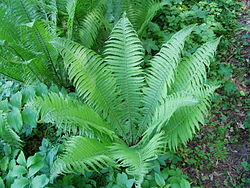| Onocleaceae | |
|---|---|
 | |
| Scientific classification | |
| Kingdom: | Plantae |
| Clade: | Tracheophytes |
| Division: | Polypodiophyta |
| Class: | Polypodiopsida |
| Order: | Polypodiales |
| Suborder: | Aspleniineae |
| Family: | Onocleaceae Pic.Serm. |
| Genera | |
| Synonyms | |
| |
Onocleaceae is a small family of terrestrial ferns in the order Polypodiales. [1] It is placed in the suborder Aspleniineae in the Pteridophyte Phylogeny Group classification of 2016 (PPG I). [2] Alternatively, the family, along with Blechnaceae, may be placed in a very broadly defined family Aspleniaceae as the subfamily Blechnoideae. [3] The family may contain from one to four genera, consisting of five species largely in north temperate climes. The four genera, Matteuccia , Onoclea , Onocleopsis and Pentarhizidium , may be included under the single genus Onoclea. [4]